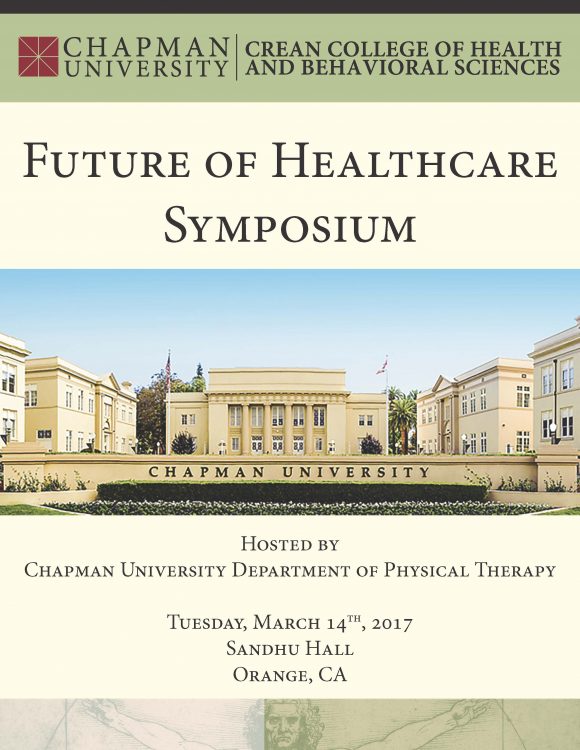DPT Healthcare Symposium Focusing on the Future of Healthcare for Physical Therapy
April 4, 2017
March 14th through Thursday March 16th 2017 Chapman University’s Doctor of Physical Therapy program conducted a curriculum review symposium. For the morning of the first day of the symposium, students were invited to attend in order to hear from professionals in physical therapy and the local community regarding current issues in educating health care providers, as well as current issues in the physical therapy community. Those invited to speak at the symposium the first morning included: Katherine Sullivan, PT, Sharon Dunn, PT, PhD, OCS, APTA President; Jan K. Richardson, PT, PhD, OCS, FAPTA, President (1997-2000); Charlotte Royeen, PhD, OTR/L, FAOTA; Christopher Powers, PhD, PT, FAPTA; and Steven Cramer, MD. The purpose of this event was to assess how the DPT program can change the curriculum to best equip future physical therapist graduates.
One of the main topics discussed is that current physical therapist students need to know and be aware of the current challenges that face physical therapists in the workplace today. As Dr. Dunn explains, health care today is in an uncertain state resulting in disruption, as well as a need for innovation and discovery. Dr. Dunn states, the way to prepare graduates is to teach them how to thrive in changing environments. Physical therapy is a profession that has value and graduates must know and advocate for physical therapy in the medical world. Dr. Powers explained that physical therapy, as a profession, is in need of  defining what it is and what makes it unique from other health care providers. The importance of this is so that the public knows and understands what physical therapists do and why they are important in the management of health care. In order to do this, Dr. Powers explains that each therapist must know what a movement system is as it is the core of the education and practice of physical therapy. Therefore, this idea and knowledge of what a movement system is should be integrated into the physical therapy education early on in the curriculum, especially since physical therapist students are trained to become movement system specialists. Dr. Powers states that a movement system “represents the collection of systems that interact to move the body or its component parts.”
defining what it is and what makes it unique from other health care providers. The importance of this is so that the public knows and understands what physical therapists do and why they are important in the management of health care. In order to do this, Dr. Powers explains that each therapist must know what a movement system is as it is the core of the education and practice of physical therapy. Therefore, this idea and knowledge of what a movement system is should be integrated into the physical therapy education early on in the curriculum, especially since physical therapist students are trained to become movement system specialists. Dr. Powers states that a movement system “represents the collection of systems that interact to move the body or its component parts.”
Another topic discussed is how to utilize what is occurring in healthcare currently, as well as what is thought to emerge in health care in the future, to assist with deciding what needs to be included in the curriculum. Dr. Royeen explains that there are three main aspects that curriculum renewal needs to incorporate in order to best guess what the future of health care and physical therapy will be for graduates. These include: (1) educating for the future, (2) educating using active learning, and (3) educating based upon skill sets needed for the next couple of decades. While the future is unknown in health care, especially with consistent changes in the governmental position of what healthcare reform should look like, there is still a sense of unknown in graduates could encounter in the future of physical therapy. In order to best incorporate the three main aspects talked about Dr. Royeen explains that there are three ways learning should be designed and one concept that the process of learning must foster. Dr. Royeen states that learning should be: (1) based upon active learning, ongoing assessment, and being application oriented, (2) evidence based and brain based learning, and (3) including technology, team collaboration, and teacher facilitation. Dr. Royeen explains that changing a curriculum with a focus on what she explains is a process that requires time and intentionality.
One final topic discussed by Dr. Powers and Dr. Cramer, which applied more to current students, was the fact that there is a great need for more physical therapists to go into doing research, as well as a great decrease in DPT graduates furthering their education with a PhD. The most common cause of this is due to financial burdens from just getting through undergraduate at graduate school. The desire is to find a way to get more physical therapists to engage in research, as well as continuing their education by getting a PhD.
The first morning of this symposium was filled with many ideas to help faculty and staff be best equipped when the current curriculum for the Chapman University DPT program would be reviewed a couple days later. It also gave students an idea of what goes into creating and changing the curriculum, as well as what is currently going on, and what is hopefully going to change, for the physical therapy profession.
Author: Katelyn Penfold ‘17, DPT Student


